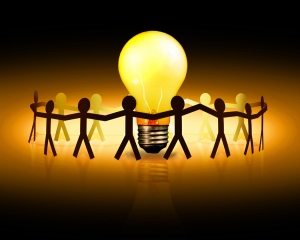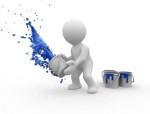— The Engaging Event Series, #5 —
 Today I feel like telling you about some overlapping ideas I’ve stumbled across from three very different people, who all happen to be brilliant, creative thinkers. Each of these ideas has something to do with the challenge of helping people get into a mental and emotional space where they can most effectively absorb new information, brainstorm ideas, solve problems and develop creative solutions. In other words, think differently.
Today I feel like telling you about some overlapping ideas I’ve stumbled across from three very different people, who all happen to be brilliant, creative thinkers. Each of these ideas has something to do with the challenge of helping people get into a mental and emotional space where they can most effectively absorb new information, brainstorm ideas, solve problems and develop creative solutions. In other words, think differently.
Up first: Jeff Lieberman, host of the awesome Time Warp program on the Discovery Channel. Jeff says that creativity does not involve thinking; it involves attention–being in the moment. As he puts it, “Creativity comes from the moments we stop thinking.” Here’s what Jeff has to say about the popularity of his TV show:
“The pieces that I developed in the arts and on the TV show created this feedback cycle where I noticed more and more that what I was working on was primarily engaging because of this initial sense of wonder it created. No matter what information you want to get across, this initial emotional reaction is necessary.” Simply put, this is what we mean by “getting their attention”.
Jeff says he noticed that people are only watching his show because in the first few seconds of each program, they see something that is totally foreign to them, and that opens them up. “When you’re in that receptive state, everything is different. When you’re in a state where you know that the things you are observing are outside of your realm of experience, you open yourself up to treating things in new ways. It’s always about that initial three seconds, when you first engage this animal impulse of wonder and your audience is left speechless.” This is the true opposite of boredom—where we begin to “tune out” and, eventually, change the channel. That’s the natural enemy of engagement and change.
I heard a similar message in a conversation I had recently with Russ Bennett, a designer, builder, sculptor, musician and social activist who lives just over the mountain from me in Waitsfield, Vermont. Russ has done visual design and site layout work for most of Phish’s large extravaganzas as well as the incredibly successful Bonnaroo music festival in Tennessee (a worthy focus for a future blog post on the power of events—stay tuned). Russ believes that when you create an experience with music or theater, your audience comes to you with an open mind—and if you associate an agenda, learning objective or cause with the experience, you can truly move people to change the way they think and ultimately the way they behave. In the case of a festival like Bonnaroo, the context of camping out with 80,000 strangers and sharing a vibrant, multi-sensory cultural experience takes people out of their normal day-to-day operating mode and opens them up to new experiences, as well as new ways of thinking about things. And evolving our thinking is the first step in improving our actions and results.
80,000 strangers and sharing a vibrant, multi-sensory cultural experience takes people out of their normal day-to-day operating mode and opens them up to new experiences, as well as new ways of thinking about things. And evolving our thinking is the first step in improving our actions and results.
Why is this so? I got some insight into this from a webinar I attended last month led by Andrea Sullivan, who runs a company called BrainStrength. Andrea explained that “states of mind” are the emotional, cognitive and physical condition from which people are operating at any given moment. (In the events business, we might also think about states as “experiences”.) The more of the brain that is activated by the immediate experience, the more your audience will become engaged. Activating not only the mind, but also the body and multiple senses, will increase the impact. Whenever your body is engaged, your brain is engaged and focused on that very moment, as opposed to thinking something that happened this morning or that needs to happen by tomorrow. Again, as Jeff Lieberman says, creativity comes from the moments we stop thinking.
 The brain also responds powerfully to emotion. So creating personal meaning for people—establishing relevance to their lives and the things that are important to them—can build an emotional connection that will support a change in thinking. Tapping people’s emotions helps them learn, by opening them up. If you can create a context and activities that put people in such a state and then attach good feelings to it, you will be well on your way to getting your attendees into creative learning mode.
The brain also responds powerfully to emotion. So creating personal meaning for people—establishing relevance to their lives and the things that are important to them—can build an emotional connection that will support a change in thinking. Tapping people’s emotions helps them learn, by opening them up. If you can create a context and activities that put people in such a state and then attach good feelings to it, you will be well on your way to getting your attendees into creative learning mode.
Of course, you don’t have to blow up a banana or build a campground for 80,000 people to accomplish this (although it certainly might help). These principles can work in any situation, with any size group–even with an audience of one. But when you’re designing this initial experience, it’s generally not a bad idea to have fun and include some simple physical activity. And if you can start out by creating that little sense of wonder–that intriguing idea, image or experience that falls outside of our normal experience–that will set the stage for receptivity and creative thinking.
What are some innovative ways you have seen or done this yourself? Feel free to add a comment below…








